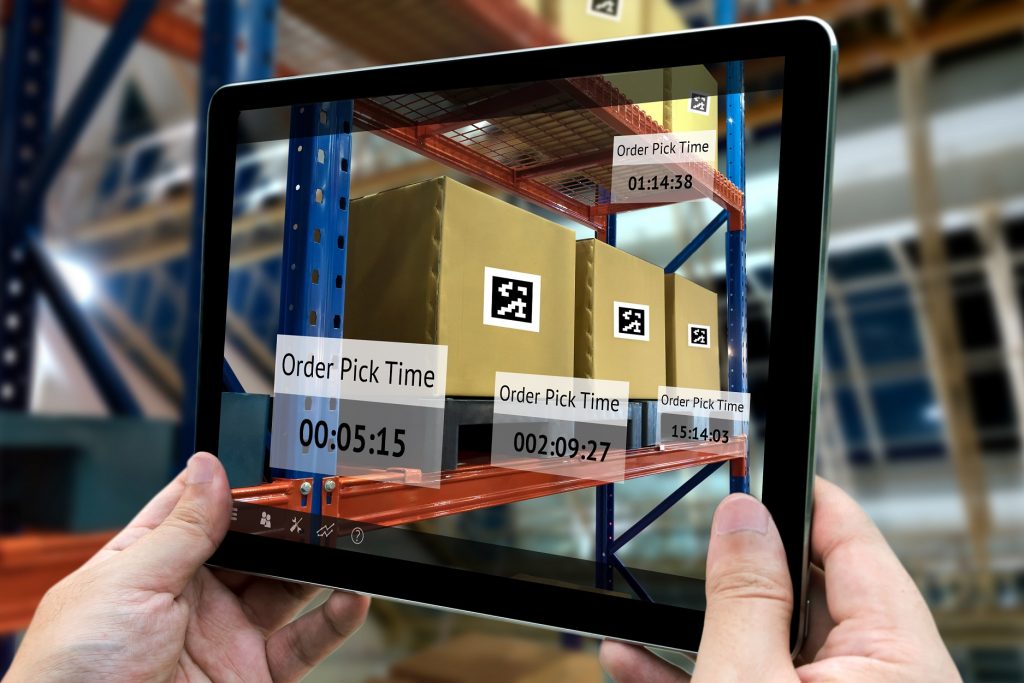How logistics companies can benefit from AR (AR in Logistics Business)

Timely and proper delivery is crucial for ensuring a positive customer experience in the cargo transportation business.
This obliges market players to have a reliable digital infrastructure. How can the logistics industry benefit from augmented reality?
From smart warehouse management solutions to supply chain systems, the transportation sector has started to transform the way it maintains its business processes digitally.
How DHL uses augmented reality
According to a report by DHL, warehousing operations like packing, storage, and put-aways form around 20% of all logistics expenses.
The task of picking orders forms about 60% of all warehousing operations. So DHL decided to cut its expenses significantly by setting the picking process on the new level using augmented reality.
In 2017, DHL launched its Vision Picking pilot project that brought AR smart glasses-based vision picking to warehouse operations.
These AR smart devices provide employees with a digital picking list and show them the best routes so as to cut their travel time by instant and accurate path planning.
Through barcode scanning, smart glasses allow employees to understand whether they are at the necessary location and help t18hem efficiently locate necessary items on shelves.
The experiment with the implementation of augmented reality resulted in the 25% growth of the total picking efficiency along with increased productivity and reduced error rate.
The initiative also allowed DHL to cut the time needed for both employee training and onboarding by 50%.
Since Vision picking proved its efficacy, DHL decided to turn the AR pilot program into the permanent approach of the further company’s improvement vector. The transporter is exploring new ways of how to apply augmented reality in employee training, transportation optimization, last-mile delivery, etc.

Understanding augmented reality
Augmented reality is a technology that allows overlying physical objects with additional information using the screens of smart devices like AR smart glasses, tablets, and smartphones.
Thus, AR is a super laying physical reality with computer-generated information. This information can be any type of content including images, text, video, etc.
However, AR is more than showing additional details. It creates a unique user interface that allows a new way of how people interact with their environment.
AR consists of four basic processes that make an additional information layer possible.
Scene capture
The first process is capturing a piece of the environment through a built-in camera of a mobile device or head-mounted display (HMD).
Scene identification
At the second stage, an AR system scans the captured environment to determine where to add predefined content. This point can be identified either by visual markers or tracking tools like GPS, sensors, infrared, or laser.
Scene processing
Once the necessary scene is identified, AR systems request the required content to be added from a connected database.
Scene visualization
At the final stage, an AR system generates a complete image that combines a captured scene and virtually added content.

How logistics companies can benefit from AR
In fact, both pick-by-vision and SWIS specialties provide logistics companies even with much more benefits than described above.
In this paragraph, we will cover how transportation businesses can use augmented reality to take maximum advantage of its capabilities.
Transportation optimization
Advanced digital technologies have significantly transformed the logistics sector. They ensured a higher level of the efficiency and productivity of the freight transportation.
AR also has the potential to improve the industry in such aspects as completeness checks and freight loading.
Completeness Checks
Augmented reality can ensure efficient pickups. An AR-enabled device can quickly check the load if it’s complete by scanning barcodes. Unfortunately, this checking process currently requires manual barcode scanning.
Though, in the long-term perspective, wearable AR devices will be able to determine the number of freight items and their volume with special scanners and sensors.
The measured data will be compared to necessary values this way informing warehouse operators about the load completeness.
AR systems also can also detect damages by scanning items.

Freight Loading
Cargo transportation involves a considerable volume of management work. This requires a high level of responsibility, accuracy, and optimization when working with freight sizes, destination, weight, etc.
With a pick-by-vision capability, augmented reality can eliminate the need for using printed freight lists and load instructions.
Using AR devices, loaders can instantly get information about which item to pick and where to place it without exploring dozens of paper documents.
Furthermore, AR systems can point to the right location in the truck for a specific item. This becomes possible through an object recognition capability integrated into the AR solution.
It allows loaders to use the available loading space more effectively compared to subjective human estimation.

Last mile delivery
The growth of e-commerce resulted in last-mile delivery services offered by numerous transportation companies. It’s the final and quite an expensive stage of the order delivery process.
DHL says that truck drivers spend about 50% of all work time not driving. Instead, they locate boxes to prepare their vehicle for the next delivery.
To cut the cost of delivering orders to a customer’s doorstep, logistics companies should implement AR solutions.
To find a necessary box, drivers can use an AR device. It will help them find this box and instantly obtain all the necessary information including a type of good, weight, address, etc. Therefore, the search process is more comfortable and faster with augmented reality.
To close the vehicle door, drivers have to put items on the ground to free their hands. In this case, the freight often gets damaged.
With AR, drivers can close the door with an eye movement or use a voice command. Thus AR technology allows companies to decrease the percentage of damaged freight.
Assembly and Repair
In addition to transportation, some logistics companies provide additional services such as assembly and repair.
In particular, apart from delivering components for Audi, DHL also assembles them into complete inside door panels before transporting them to car plants.
Indeed, such complex skills require long and intensive training for employees at logistics providers. Any error can be costly.
AR technologies can help transportation providers match-high assembly standards by monitoring the assembly process using advanced image recognition capabilities.
In addition, AR systems can help technical specialists detect and fix both damage and errors by identifying problems via image recognition and providing staff with detailed repair instructions through AR smart glasses.
Implemented augmented reality will significantly reduce the time for repairing and cut the overall error rate.

Customer Services
Augmented reality can also improve the level of customer services in transportation.
By scanning cargo with AR-equipped devices, companies can pack the freight in perfectly sized boxes and accurately determine the needed space for loading while offering the lowest service price due to advanced optimization techniques.
Through an AR device, transportation companies can provide their customers with better control over the price forming process and, as a result, increase their trust and loyalty.
Final Thoughts
Augmented reality offers a set of key capabilities that can significantly improve the productivity, efficacy, and cost-effectiveness of the logistics business.
Through optimizing warehouse operations such as picking, packing, and loading as well as improving employee training and expanding a list of services, market players can both reduce their expenses and increase income.
Indeed, augmented reality has the potential to revolutionize the way how supply chains are organized in different companies by improving their efficacy rather than transforming their structure.
The example of DHL clearly proves the vital necessity of integrating AR systems for those who provide freight transportation services.
Transportation companies should be aware of the benefits of the implementation offered by augmented reality in logistics and strive to be among the first adopters to remain competitive in this market.
Moreover, they should explore new ways of using AR to gain advantage from this technology. We at Jasoren have deep expertise in applying AR capabilities in different industries including logistics.
Apart from developing high-end solutions, we are ready to offer you various ways of utilizing augmented reality for your company to maximize your benefits over competitors and help you gain more profit due to innovative AR technology.
Cre: https://jasoren.com















Leave a Reply